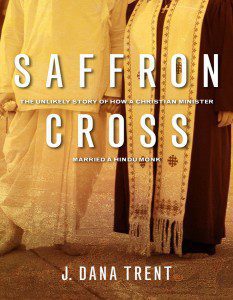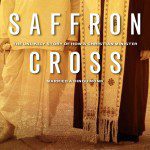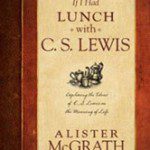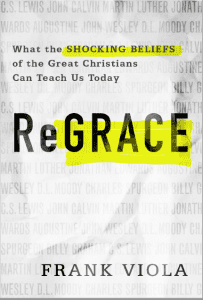Indeed, it is rather rare to find a Christian minister married to a Hindu monk in this world, and it is also quite possible that they are the only such couple in the world, making the book Saffron Cross: The Unlikely Story of How a Christian Minister Married a Hindu Monk written by Dana Trent, the Southern Baptist minister, a very interesting read, with some fascinating insights into the dynamic of making such a marriage work.
The slim, 140 plus pages of this personal account, from the days sitting in her pajamas filling out the detailed questionnaire on eHarmony.com to the early days of dating Fred Eaker (whose last name you won’t find mentioned in the book), the lapsed Hindu monk, whose ordained name is Gauravani Das, and the first two years of their rather challenging marriage (with all the doubts, it seems, on her part, and very little, it seems, on Fred’s part) is overall fun, easy, and light reading. If you want to find a deep and carefully explicated commentary on the differences in the epistemological, ontological, soteriological, and ethical aspects of each “religion” and hair-splitting on moksha, dharma, and Christian eschatology this is the “wrong” book. Nor would you find anything deeply insightful about yoga, meditation, karma, renunciation, and dharma in the book, let alone the debate among Gaudiya Vaishnavas about “Achintya bhedābheda,” making this a simple but inviting account of the dynamics and the attraction between two unlikely partners in a marriage both of chance and choice.
What is likable in Trent’s account is her sympathetic, sometimes wide-eyed observations about life in Vrindavan, a village/small town close to Mathura, the larger city, considered the birthplace of the God King, Lord Krishna, and where Trent, a Southern Baptist minister spends two weeks on a “honeymoon” with her Guadiya Vaishnav, ex-Hindu monk husband – sexless, bathroom tissue-less, and meat-less! Her observations ring true, though somewhat context-less and superficial. India is what it is, and life in Vrindavan is how it is for a variety of reasons, and there is a potential therefore for readers who are ignorant about Indian history and culture, and Hindu ways and beliefs, to go to bed with many of their stereotypical ideas about India and Hindus solidly confirmed. Hinduism, India, and even Christian beliefs and practices come in thimblefuls in this book, but most of the content is crafted with good intent and cheer.
Fred is a Hindu monk — a White, American, blue-eyed, and handsome convert to Gaudiya Vaishnavism, a sect whose founder Chaitanya Mahaprabhu (1486-1534), was from the eastern Indian region of Bengal (now West Bengal and Bangladesh), and whose influence till this day is limited in India, but whose philosophy and life has gained much traction in the West, especially the U.S., after Sri Bhaktivedanta Swami Prabhupada founded the Krishna Consciousness Movement in New York City in 1966. Even this little history does not find mention in Dana Trent’s account, but indeed that works well in the overall thrust of her book, which is to tell lightly and focus solely on her story of how she met, dated, and wed Fred, and the two years of testing times as she sought to reconcile her Baptist background with Fred’s Gaudiya Vaishnav affiliations and commitment.
Even in the recounting of the times of deep anxiety and distress, Trent succeeds in maintaining a tone of light-heartedness that works very well in narrating this unique story. She is open to Fred’s ways and beliefs even as she struggles with adopting a vegetarian lifestyle, deity worship, a simple, less materialistic approach to discovering and celebrating God and grace, and dealing with a deep-seated anxiety about her own understanding and knowledge of Christianity. Even her account of visiting a local Hindu temple in the Raleigh-Durham area, at the end of the book, is imbued with a sense of discovery, innocence, and acceptance that makes her story attractive, easy to follow, and celebratory without it being a wishy-washy, “we are all one family,” mawkish, kumbaya jingle.
Of course, both Christians and Hindus could quibble and complain about her understanding and practice of Christianity or knowledge of Hinduism, and that would be correct but beside the point. It would be a waste of energy and time because her stance is not one of a critic, scholar, ideologue or an outside observer of religion and religious practices but that of a partner and participant in a rather unique marriage: a coming together of two people whose beliefs, life experiences, and commitments are melded in a way that is healthy, accepting, and ultimately a quest for God in His/Her many manifest forms and appearances. Yes, there are parts in the book (not too many) where a reader can go “ouch” – like here: “In my fantasy, I had imagined a perfect balance of the best of our Christian and Hindu traditions, like if Mother Teresa married Gandhi” (p. 78), wondering really how much the author knew or cared about “Mother” Teresa or “Mahatma” Gandhi! I had to quickly put aside my complaint, realizing that Trent was not trying to make some weighty argument but just trying to get to those “ordinary readers,” through a well-meaning but hilariously awkward analogy and example.
Yes, there are some fundamental divisions and differences between Christianity, a prophetic religion — that makes many of its adherents fundamentalist in their belief about the nature of God, the role of Jesus, and about others’ conceptions, experiences, and beliefs about God/s and humans – and Hinduism, a “rolling caravan of conceptual spaces,” whose practitioners embrace and “perform” their religious faith in ways that are incomprehensible and strange for those tied to a single book. Thus, despite knowing, loving, and marrying Fred, the author has some questions for Fred’s guru, Swami Tripurari, a former Catholic, and a Gaudiya Vaishnav adept and student of Swami Prabhupada: do we need an intermediary (in the form of a guru, priest, teacher) to know God? Isn’t deity worship idolatry? And can an interfaith marriage work when there are some fundamental disagreements between the two faith followers? Swami Tripurari’s careful, considered, and sympathetic responses and solutions provide the author the ballast necessary to not only understand and clarify her own doubts but to renew her faith in her own traditions. The traditional Hindu response to those who fall in love with Hinduism is to say “don’t convert to a new faith, but just follow the best in your own traditions.” So, in the ten-day visit to the spiritual retreat of Audarya, north of San Francisco, Dana Trent finds out that that is what she too can do in her pursuit of God.
I believe that most readers of the book will close it with a smile on their faces for there is very little that is contentious about God and religion in the book. It may spur some in their own quest for understanding and acceptance, as well as in their search for new experiences in religion, spirituality, love, marriage, and partnership. It might start conversations over wine in the confines of liberal households, and some contesting among academics and church leaders in conferences and in church discussions; and some readers might be tempted to go in search for information and arguments, about theses and theologies. For most Hindu readers, I believe, this is a book which will confirm their own belief in maya, karma, and Krishna lila.
To read an excerpt from Saffron Cross – and for more responses from our bloggers – visit the Patheos Book Club here.
 Ramesh Rao, Professor and Chair, DN3 Program, Columbus State University, Columbus, GA, is the author of two books on Indian politics and society and has written numerous op-eds for newspapers and magazines in India, the U.S., and the U.K. Ramesh served as Human Rights Coordinator and Executive Council member at the Hindu American Foundation between 2004-2013. He spent the first twenty-eight years of his life in India where he worked as a bank officer, a school teacher, and a copy editor. He received his MS in Mass Communication from the University of Southern Mississippi, and his PhD in Communication from Michigan State University. He taught at Truman State University in Kirksville, MO, and Longwood University in Farmville, VA, before he joined Columbus State University. He lives with wife Sujaya, and son Sudhanva in Columbus, GA.
Ramesh Rao, Professor and Chair, DN3 Program, Columbus State University, Columbus, GA, is the author of two books on Indian politics and society and has written numerous op-eds for newspapers and magazines in India, the U.S., and the U.K. Ramesh served as Human Rights Coordinator and Executive Council member at the Hindu American Foundation between 2004-2013. He spent the first twenty-eight years of his life in India where he worked as a bank officer, a school teacher, and a copy editor. He received his MS in Mass Communication from the University of Southern Mississippi, and his PhD in Communication from Michigan State University. He taught at Truman State University in Kirksville, MO, and Longwood University in Farmville, VA, before he joined Columbus State University. He lives with wife Sujaya, and son Sudhanva in Columbus, GA.
Rao’s column, “God in the Age of Kali,” is published every Monday on the Hindu portal. Subscribe via email or RSS.













